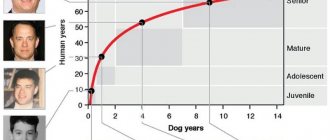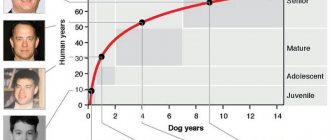There are many unscrupulous owners. Some people do not carefully monitor animals - dogs run away, others throw an animal that does not suit them into the street. When a dog is selected and found, the question arises of how to determine the dog’s age. This is necessary for examination by a veterinarian, vaccination, to create an announcement about the foundling, in order to know how to care for it, what to feed and how long to walk.
To determine the age, the pet is examined. As a person grows and ages, special signs appear, similar to what happens in animals. A puppy cannot be confused with an old animal. Veterinarians know how to find out a dog’s age more accurately by external signs. And among dogs there are long-lived people. The oldest dog died at 29 years old, but this is a rare exception. Most dogs live 10-16 years.
The second common question among pet owners related to age is whether it is possible to compare it with a human one. Knowledge is not very important, but interesting. The age of a dog by human standards can be approximately calculated using coefficients or viewed more accurately in special charts.
Relationship between a dog's age and human years
Are you wondering how old your four-legged friend will be, in human age? To get the equivalent human age of a pet, you just need to multiply it by 7 or 6. This is approximately the case. Compare: dogs reach adulthood already at the age of two, when people need 18 years to do this. At 18 months, the dog will feel as fresh and cheerful as a person at 20.
On average, a dog lives up to 12 years. The figure depends on the breed, quality of life, genetics and other factors. Converted to human years, this would be approximately 64-77 years. When a dog turns 16, he feels like a full-fledged 90-year-old inhabitant of our planet.
There is another version. To obtain a dog's age similar to a human's, the multipliers must be gradually changed. For example, when a puppy is 2 months old, we multiply its age by 7, we get 14 human years. But upon reaching the age of six months, the puppy jumps sharply in development and its age is already equal to 5-6 human years, since the multiplication coefficient immediately changes to 10. 1 year is equal to 15 human years.
It is impossible to compare human and dog (or cat) ages with 100% objectivity, so we are content with those calculations that are quite realistic to make.
Long-lived dogs – TOP 5 breeds
There are several dog breeds that are distinguished by good health and long life expectancy.
- The New Guinea Singing Dog is an aboriginal breed with excellent health and strong innate immunity. The dog is notable for the fact that its average lifespan is from 19 to 20 years. Moreover, females are capable of producing full-fledged offspring up to 12-13 years of age.
- Chihuahua is a Mexican, representative of the smallest dogs. The advantage of a Chihuahua is good health and the absence of hereditary diseases, but in cold weather it is recommended to wear dog overalls for walks to avoid colds. The average life expectancy is 17 years, but with good care it lives 20-22 years.
- The toy poodle is a German decorative dog (height at the withers is 15 cm). One of the positive qualities of a living toy is its significant life expectancy, which is 17 years and above.
- The Jack Russell Terrier was bred in Great Britain as an excellent companion and hunter. He is very active and needs frequent walks and lots of exercise. The owner can enjoy companionship with his friend for 16-20 years.
- Cockapoo is an artificially bred cross between a miniature poodle and a cocker spaniel. Thanks to the efforts of breeders, the dog has a lot of advantages. Will stay with the owner for 17-20 years.
What dog breeds live the shortest?
Dogs of impressive size have the shortest life expectancy. It’s a shame that these smart and devoted friends can only stay with their loving owners for no more than 10 years.
- The Dogue de Bordeaux was developed in France. A very beautiful, confident and calm dog of large size, with strong bones. The average lifespan is short and is 6-8 years.
- The Great Dane is another representative of the giant breeds. This is a devoted, faithful and very smart friend. The breed is rightfully considered aristocratic, but does not live long - 7-8 years.
- The Bernese Mountain Dog was born in Switzerland. This is a representative of large herding dogs. Apartment housing and its companion – physical inactivity – have a very bad effect on the pet’s health and shorten years of life. On average, the Bernese Mountain Dog lives 8-10 years.
- The Irish Wolfhound is a large, wire-haired dog bred specifically for hunting wolves and other large game. Possesses fragile health and low life expectancy (6-8 years).
- The Neapolitan Mastiff is a large dog, fearless in battle with enemies, faithful and devoted to its owner. Even with good care, the Neapolitan Mastiff lives 6-8 years.
Why do small dogs live longer than big ones?
Biologist Cornelia Kraus from the University of Gettin, conducting research with large and small dogs, noticed the following pattern: the rate of aging of animals depends on the presence of growth hormones in their bodies, in particular the insulin-like growth factor IGF-1, produced by the liver. Cornelia suggested that large puppies contain more of it, because they grow in height more rapidly:
- a poodle puppy, when it reaches one year, becomes 20 times heavier;
- A Great Dane puppy becomes 100 times heavier after living for a year.
The biologist suggested that the rapid aging of large dogs is a side effect of the presence of this hormone in the body. Thus, dog years and the level of development in large and small pets are almost identical in the first years of life. The difference begins to increase rapidly after the fifth year of life.
Determining the age of the puppy
Finding out how many months a puppy is is not as difficult as an adult dog.
- A newborn puppy can be identified just by looking at the four-legged animal. His eyes are closed and there are no teeth at all. The puppy does not walk yet, he sleeps most of the time. The baby just squeaks quietly to attract her mother's attention. Using touch, he finds his mother's nipples and feeds only on breast milk. It will remain this way until about 2-3 weeks of life.
- After the first weeks, the puppy’s eyes gradually open, but he still cannot see fully. Gradually he distinguishes sounds and smells.
- From the first month of life, the baby begins to walk and explore the world around him. The exact age from a month to a year can be determined by the condition of his teeth. Up to 2 months, your pet’s baby teeth are just forming. Starting from the second month of life, baby teeth are replaced by molars. By the age of 1 year, the dog's molars should be fully formed. Between 6 and 12 months, puppies begin puberty, and girls go into heat.
- From 1 to 2 years old, a dog is considered a teenager. Dogs of large and medium breeds stop growing at this age. Large breed puppies continue to develop until they are 2 years old. Starting from the age of two, the pet is considered an adult.
Stages of life
- First stage: childhood. Lasts approximately six months after birth. During this time, the kitten learns about the world around it and its dangers, and constantly receives new information. For now, he walks next to his mother, who teaches him everything and protects him from dangers. At the end of the first stage of a cat's life, we have an 8-12 year old child.
- Second stage: youth. Lasts from six months to two years. Feline puberty, period of growing up, puberty. By the age of one year, the cat is already biologically ready to give birth, but it is better to wait until two years - by this time she has acquired all the vital skills and abilities.
- Third stage: youth. Peak of development and activity. It lasts from three to five years. The cat is playful, intelligent, inquisitive and very active. Ready to reproduce healthy offspring. If we compare this with human life, then here we are no longer a teenager, but a young man who has graduated from university and found a good job.
- Stage four: maturity. From the seventh to the tenth year of life. The cat becomes cynical and indifferent in its views on the world; it worries it less. More time is spent sleeping, and the animal’s gaze itself becomes disdainful and proud. The cat is still healthy and has a lot of energy, but she no longer has much desire to waste it on stupid games.
- Fifth stage: retirement. It is only thanks to today's veterinary advances that cats have begun to discover this magnificent stage of their lives en masse. Now they enjoy life like people of about 60-70 years old. Such animals live exclusively for themselves and for their own pleasure. They sleep, eat and look at the birds in the windows for a long time, no longer trying to catch them, no longer getting nervous.
- Sixth stage: old age. Cats at 15-16 years old are already considered long-lived. If your pet or pet survives to this stage, you are lucky. During this period of life, they become affectionate, faithful, and require more attention, love, care and warmth.
https://youtube.com/watch?v=sffK5XP0Bfw
Teeth
It is easy to determine the age of a dog by looking at its teeth. Veterinarians and dog handlers most accurately determine the age of an animal precisely by the condition of its teeth. Below is a complete table of the relationship between the number of teeth a dog has and its age.
| Age | Dental condition |
| From birth to 2-3 weeks | No teeth |
| 3-4 weeks | Milk hooks and fangs are just beginning to emerge |
| 4-5 weeks | Deciduous incisors appear |
| 5-7 weeks | The remaining teeth are emerging |
| 2 months | All baby teeth are there |
| 2-4 months | First, hooks and fangs are replaced with molars. |
| 3-5 months | Middle incisors change to molars |
| 4-6 months | Deciduous rear incisors are replaced by molars |
| Six months | Baby fangs are the last to fall out |
| 1 year | White teeth with tubercles |
| 2 years | On the lower toes, the tubercles are gradually worn away, but the teeth do not lose their beautiful appearance |
| 4 years | The upper tubercles wear away, the teeth lose their brightness |
| 5 years | Yellow plaque on teeth, possible formation of tartar |
| 6 years | Teeth are yellow, wear out, change shape |
| 8-10 years | The fangs are dull, the teeth are very worn. The enamel is clearly yellow |
| Over 10 years old | Teeth loosen and fall out, bite is disrupted |
By external signs
Umbilical cord. The presence of an umbilical cord indicates that the puppy was recently born. If the umbilical cord is still fresh, the puppy is no more than a day old. On the 2nd day it dries up, and on the 3rd it is already separated from the dog’s belly.
Eyes. The puppy remains blind until 10-20 days of its life. The eyes should open before the first month. The cloudy and gray-blue color of the iris is characteristic of tsutsiki for up to a month. Clear eyes are characteristic of dogs one month and older. It is worth paying attention to the dog's gaze.
Ears. In the first days of life, the puppy does not hear anything. The baby will begin to recognize the first sounds only after the second week of life, and to fully hear by the month. As the puppy grows, its ears grow.
Weight. Obviously, a small puppy will weigh differently than an adult dog. There are tables of approximate weights for small and large breeds at all ages.
For dwarf breeds:
| Type | Newborn | 4 weeks | Six months | One and half year |
| Dwarf | 70-80 grams | 200-230 grams | 715-920 grams | 1-1.2 kg |
| Small | 90-100 grams | 270-320 grams | 1-1.2 kg | 1.4-1.9 kg |
| Average | 120-130 grams | 455-485 grams | 1.6-1.8 kg | 2.1-2.3 kg |
| Big | 145-170 grams | 540-650 grams | 1.9-2.2 kg | 2.4-3 kg |
For large and medium breeds, other parameters are presented. Knowing how much a dog of a particular breed should weigh at maturity, you can find out whether it has reached canine adulthood.
You need to be especially careful with giant breeds, as their dimensions develop very, very rapidly. One-month-old Labrador puppies weigh from 3.4 to 3.6 kg and grow to 30-40 within two years. The weight of an 11-month-old Rottweiler can already reach 50 kg.
Adult age
It is considered more difficult to accurately determine the number of years a dog is after three. The fact is that a dog’s age is determined mainly by its teeth. After the formation of all molars, the animal does not undergo any changes for a long time.
The dog develops fully during the second year of life. A dog that has reached not only sexual, but also behavioral maturity is considered fully mature. What distinguishes an adult dog from a puppy is a change in its behavior with others.
How to determine the physical maturity of a dog? Bitches reach puberty much earlier than males. At the age of 6-8 months, girls begin their first heat. If you notice an animal in heat, this means that she is definitely older than 8 months. It is important to monitor her all this time and prevent early pregnancy. Only a girl who has already reached 18 months of age is suitable for reproduction. Boys are also recommended to be crossed only after reaching the age of two.
A pet that has reached the age of seven can be considered elderly. Characteristic signs that the dog is old:
- The pet becomes less active, sleeps a lot, does not want to go for long walks;
- Gray hair on the face appears in a pet when it reaches 6-7 years of age. It also happens that gray hairs are found in younger individuals;
- Deterioration of hearing and vision. Partial deafness;
- Temperament changes, the animal becomes more aloof;
- Decreased appetite;
- There is no sexual desire and desire to play and meet other dogs;
- Frequent urge to urinate, problems with digestion.
The above signs are normal for an older dog. But if such oddities are noticed in the behavior of an animal that, according to other signs, has not reached the age of seven, this may indicate various kinds of diseases. Be carefull!
How many live on the street and at home?
German Shepherds that live outdoors have a longer lifespan than those that live indoors.
This is due to the characteristics of the breed itself. Germans need physical activity, in which it is difficult and impossible to limit them, as well as mental activity, which manifests itself in training.
If you take away these aspects of your dog's life, it will have a negative impact on their physical and mental functioning.
The dog may become aggressive, its muscles will begin to weaken, and it will no longer be able not only to stand up for itself, but also to protect its owner.
If a German Shepherd is constantly kept in an enclosure on the street, this will lead to the same consequences.
Many dog breeds, on the contrary, feel more comfortable indoors, but the German Shepherd is not one of them. It is better and healthier for her to be outside - she is not afraid of rain and cold because of her dense undercoat and good coat.
Therefore, we can say with confidence that dogs living in the courtyard of a private house live much longer than those who have to huddle in an apartment.
But this does not mean at all that a German Shepherd cannot live indoors . Just provide her with the right amount of physical and mental stress.
Medium dogs up to 12-25 kg
Medium breeds are considered to be those that reach 10 to 25 kg in weight at the age of 1.5-2 years. To determine the age of a dog, take a look at the table below. Here are the most popular breeds and their ideal weight at maturity (+- a couple of kilograms). To understand whether your dog has passed the 1.5 year mark, weigh him and compare him with the table.
| Breed name | Weight of bitches, kg | Male weight, kg |
| French Bulldog | 11,3-12 | 13-14 |
| Cocker Spaniel | 11,8-13 | 13-15 |
| Staffordshire Bull Terrier | 21 | 24-25 |
| Collie | 19-21 | 23,9-24,4 |
| Siberian Husky | 18,5-19,5 | 24-25 |
| Shar Pei | 18-20 | 24,9-26 |
Lebeau's theory
In the middle of the last century, a veterinarian from France A. Lebo developed his theory to calculate the age of a dog in relation to a human, which is based on the accelerated development of four-legged pets in puppyhood. In his calculations, he compared the period of puberty, maturity and average life expectancy in pets and people.
According to his calculations, the development of a dog at 12 months is the same as that of a teenager at 14–15 years old, 2 years correspond to 23–25 years of a person, each subsequent year of an animal’s life is equal to 4–5 human years. But in his calculations the doctor did not take into account the size of the pets.
Separation of dogs depending on body weight
| Group | Representatives | Weight, kg) |
| Small dogs | Toy terrier, pugs, Yorkshire terrier, Pekingese, Pomeranian. | No more than 10 |
| Average | American, English cocker spaniel, basset hound, bulldogs, dachshunds, husky. | 11–25 |
| Large | Labradors, greyhounds, Staffordshire terrier, German shepherd, husky. | 26–45 |
| Gigantic | Great Danes, Newfoundlands, Mastiffs, St. Bernards, Deerhounds. | More than 46 |
Large from 25 kg
Large breeds are those whose weight ranges from 25-40 kg. Anyone who weighs more is considered a giant. The formation of such breeds as the Rottweiler or the German Shepherd completely ends when they reach two years of age. Puppies are already born large, weighing 3-4 kg.
| Breed name | Weight of bitches, kg | Male weight, kg |
| Golden Retriever | 30 | 33,7 |
| Labrador | 30-34 | 35,5-39,5 |
| German Shepherd | 28,4-30 | 35,9-40 |
| Boxer | 28,8-31 | 33,9-38 |
| Doberman | 28-33 | 39-44 |
| Rottweiler | 39,7 | 46,8-54 |
| Saint Bernard | 61-67 | 81-88 |
Tough
The expert will first look at the condition of the animal’s teeth. By the presence or absence of certain fangs, you can find out the age of the puppy. The age of an adult dog is determined by the presence of all molars and cusps on them. Above is the most complete table showing the correspondence between the years of an animal’s life and the approximate condition of its jaws.
The disadvantage of this method is that if the dog has a malocclusion or other jaw defects, diagnosis becomes difficult.
Basic principles
The principle of determining the age of a puppy or dog is based on the basic patterns of the eruption of baby teeth, their erasure, and then the appearance of permanent teeth and their erasure. Newborn puppies, of course, do not have any teeth. In older individuals, teeth wear down differently, it all depends on the diet and health of the animal. In determining the age of a dog, the incisors play the most noticeable role - each such tooth (more precisely, its crown) acts as three points (fields, teeth, points). It is important to remember that in most cases, both lateral incisors wear down over time to the point that they simply disappear.
According to other signs
By behavior. Little puppies love to be near their mother. They do not leave their mother, sleep, eat and play nearby, and puppies up to two weeks old cannot do anything on their own. Since a month they have been actively studying everything and walking around. From two months and older, the puppy is already running around the house with all his might and doing mischief here and there. By six months, small breeds begin puberty; large breeds mature by up to a year. Character is formed around 4-5 months.
Barking. The puppy begins to bark at 1.5-2 months of age. His voice is not so loud, but ringing and perky.
Reaction to sound. Puppies cannot fully hear until they are a month old. If the puppy does not respond to sound stimuli, either he is not 2 weeks to a month old, or he is deaf or has problems with his ears.
conclusions
The age of a puppy can be determined by the developmental phase of its grin. This is difficult to do in small breeds. The age of an adult dog is determined by the degree of wear (abrasion) of the teeth. Dogs whose oral cavity has been looked after remain with a healthy grin longer. For comparison with the examination data of the animal under study, we use the dental formula.
Please follow and like us:
Nikitin Sergey
I write about dogs based on the experience and knowledge gained during my studies as a veterinarian, work in my specialty, and simply from observing my pets.
Briefly about the main thing
- You can find out the age of your pet yourself, without the help of a veterinarian.
- First of all, look at the teeth, since the condition of the teeth can most accurately tell how old the dog is.
- Don't rush to judge prematurely. To complete the picture, conduct a full examination of the dog. This way you can objectively assess the situation and make the most accurate conclusion about its age.
Have we answered your question fully enough? If not, write your question in the comments below and our specialist will answer it.
Did you like the article? Share it with your friends on social media. networks. This will help them get useful information and support our project.
What is it for?
There are many reasons why you might need to determine the approximate age of your pet. Here are the most common ones. The age of the dog is very important for timely vaccination, since more vaccines are given at certain times. Thus, at a young age, vaccination is carried out every 12 months. And already in adulthood, your pet needs to be vaccinated much less frequently so as not to harm its health, since as it ages, the immune system becomes more vulnerable. Having information about the age of your pet, you can calculate the mating period.
When deciding to undergo spaying and castration surgery for your pet, it is important to choose the appropriate period and not harm him. The most suitable period, according to veterinarians, is 6-7 years. Features of caring for a dog depend on its age. Therefore, with this information, you can provide her with the most suitable conditions to maintain her health. In case of loss of your pet’s personal documents, the procedure for establishing the age of the four-legged animal is inevitable to confirm the information you provided.
Check out the premium and super-premium food ratings and find out whether you can give your dog dry food.











